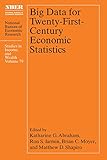Big data for twenty-first-century economics statistics
Series: Studies in income and wealth ; Vol. 79Publication details: University of Chicago Press 2022 ChicagoDescription: 489 pISBN:- 9780226801254
- 330.0727 BIG
| Item type | Current library | Collection | Call number | Status | Date due | Barcode | Item holds | |
|---|---|---|---|---|---|---|---|---|
 Book
Book
|
Jammu General Stacks | Non-fiction | 330.0727 BIG (Browse shelf(Opens below)) | Available | IIMJ-6169 |
Table of Contents: Introduction: Big Data for Twenty- First- Century Economic Statistics: The Future Is Now Part I. TOWARD COMPREHENSIVE USE OF BIG DATA IN ECONOMIC STATISTICS 1. Reengineering Key National Economic Indicators 2. Big Data in the US Consumer Price Index: Experiences and Plans 3. Improving Retail Trade Data Products Using Alternative Data Sources 4. From Transaction Data to Economic Statistics: Constructing Real-Time, High-Frequency, Geographic Measures of Consumer Spending 5. Improving the Accuracy of Economic Measurement with Multiple Data Sources: The Case of Payroll Employment Data Part II. USES OF BIG DATA FOR CLASSIFICATION 6. Transforming Naturally Occurring Text Data into Economic Statistics: The Case of Online Job Vacancy Postings 7. Automating Response Evaluation for Franchising Questions on the 2017 Economic Census 8. Using Public Data to Generate Industrial Classification Codes Part III. USES OF BIG DATA FOR SECTORAL MEASUREMENT 9. Nowcasting the Local Economy: Using Yelp Data to Measure Economic Activity 10. Unit Values for Import and Export Price Indexes: A Proof of Concept 11. Quantifying Productivity Growth in the Delivery of Important Episodes of Care within the Medicare Program Using Insurance Claims and Administrative Data 12. Valuing Housing Services in the Era of Big Data: A User Cost Approach Part IV. METHODOLOGICAL CHALLENGES AND ADVANCES 13. Off to the Races: A Comparison of Machine Learning and Alternative Data for Predicting Economic Indicators 14. A Machine Learning Analysis of Seasonal and Cyclical Sales in Weekly Scanner 15. Estimating the Benefits of New Products
This book analyzes the deployment of Big Data to solve both existing and novel challenges in economic measurement. The existing infrastructure for the production of key economic statistics relies heavily on data collected through sample surveys and periodic censuses, together with administrative records generated in connection with tax administration. The increasing difficulty of obtaining survey and census responses threatens the viability of existing data collection approaches. The growing availability of new sources of Big Data--such as scanner data on purchases, credit card transaction records, payroll information, and prices of various goods scraped from the websites of online sellers--has changed the data landscape. These new sources of data hold the promise of allowing the statistical agencies to produce more accurate, more disaggregated, and more timely economic data to meet the needs of policymakers and other data users. This volume documents progress made toward that goal and the challenges to be overcome to realize the full potential of Big Data in the production of economic statistics. It describes the deployment of Big Data to solve both existing and novel challenges in economic measurement, and it will be of interest to statistical agency staff, academic researchers, and serious users of economic statistics.
There are no comments on this title.

